
23 minute read
QSL report
QSL MARKET UPDATE
Current as of 31 August 2020.
Advertisement
Sugar
Sugar prices were able to break two technical resistance levels – 12.30 USc/lb and 13.00 USc/lb – achieving as high as 13.28 USc/lb during the past month. Speculative activity has substantially increased. The latest Commitment of Traders report showed a net-long position of 177,000 lots. This was considered a structural movement to commodities on the back of US Dollar weakness, rather than an isolated improvement in sugar fundamentals. Chinese import policy changes have increased export potential into this market, but sales have recently far exceeded expectations. The market is now trying to determine if China is ramping up purchases above normal levels, or trade flows are just reflecting tonnages previously smuggled into the country from Thailand. ICE 11 trading range going forward: 11.50 USc/lb to 14.00 USc/lb, although we’re currently encountering technical resistance at 11.33 USc/lb and 13.28 USc/lb. Closely watching: Weather, speculative activity, trading volumes, Chinese buying and overall technical indicators.
KEY INDICATORS
31/08/2020
ICE11 Prompt (JUL20) 12.6 USc/lb Brazilian Real/$US exchange rate 5.39 BRL Brent Crude Oil $US45.81/barrel Ethanol/Raw Sugar Parity 9.6 USc/lb Net Spec Position 179,000 (net long)
Monthly change
+0.74 USc/lb +0.27 BRL +$US1.53 +0.2 USc/lb +107,000
Currency
The Australian Dollar is still trading in one direction, remaining above 0.7100 against the US Dollar (USD) and reaching as high as 0.7360. Broad USD weakness is still providing support to most currencies, while equities, iron ore, gold and overall commodities are enjoying bullish sentiment. The political and economic risk in the US means this upward trend looks set to continue, which will have a negative impact on Aussie exports and will need to be closely watched. The US and China were due to review their progress in the Phase One trade agreement this month but this was delayed at late notice, causing concerns for the market. Officials suggested that the two sides were satisfied with the developments in the agreement, but other areas of the relationship have deteriorated and escalating tensions threaten to boil over. AUD/USD trading range going forward: 0.7000 to 0.7400. Risks Ahead: Second wave of COVID-19 in Australia, the US-China relationship, the next three months before the US Presidential election.
31/08/2020
$AUS/$US exchange rate $US0.72685 $US Index 92.37 Chinese Yen/$US exchange rate 6.87 CNY S+P 500 Index 3,508.01 RBA Overnight Cash Rate 0.25%
Monthly change
+$US0.0131 -2.6070 -0.1347 CNY +231.9900 -
RAW SUGAR PRICES $500 AUD Per Tonne Actual $360 $380 $400 $420 $440 $460 $480 $340 3-Jun-19 3-Jul-19 3-Aug-19 3-Sep-19 3-Oct-19 3-Nov-19 3-Dec-19 3-Jan-20 3-Feb-20 3-Mar-20 3-Apr-20 3-May-20 3-Jun-20 3-Jul-20 3-Aug-20
2020 Season 2021 Season 2022 Season 2023 Season
This is a whole-of-season ICE 11 price chart, based on the Target Price Contract’s current 3:2:1 pricing ratio for the 2020 Season and 1:2:2:1 pricing ratio for the 2021, 2022 and 2023 Seasons. Disclaimer: This report contains information of a general or summary nature and is based on information available to QSL from many sources. While all care is taken in the preparation of this report, the reliability, accuracy or completeness of the information provided in the document is not guaranteed. The update on marketing and pricing activity does not constitute financial, investment advice. You should seek your own financial advice and read the QSL Pricing Pool Terms, which are contained on QSL’s website. Nothing contained in this report should be relied upon as a representation as to future matters or that a particular outcome will be achieved. Information about past performance is not an indication of future performance. The information in the report is current as at the time of publication and is subject to change, as the information is based on many assumptions and is subject to uncertainties inherent in any market. QSL does not accept any responsibility to any person for the decisions and actions taken by that person with respect to any of the information contained in this report.
200,000 16.00 150,000 15.00 100,000 50,000 14.00 0 13.00 QSL GROWER -150,000 -100,000 -50,000 11.00 12.00 PRICING UPDATE -250,000 -200,000 26/6/18 26/7/18 26/8/18 26/9/18 26/10/18 26/11/18 26/12/18 26/1/19 26/2/19 26/3/19 26/4/19 26/5/19 26/6/19 Your Trusted Partner 9.00 10.00 26/7/19 26/8/19 26/9/19 26/10/19 26/11/19 26/12/19 26/1/20 26/2/20 26/3/20 26/4/20 26/5/20 26/6/20
Grower Pricing
A recent rally brought 2020-Season prices above $A400/tonne. Forward pricing limits for the 2021 and 2022 Seasons have been raised to 70%. QSL growers can now access the Defaulting Target Price Contract. This new pricing option lets growers place a forward pricing order that is automatically cancelled and defaults the tonnage to the Harvest Pool if the target is not reached by 15 April in the year of delivery. See your local QSL representative for details. The Pricing Completion Date for the OCT20 contract in QSL’s Individual Futures Contract and Self-Managed Harvest pricing options is 15 September 2020. Any tonnage allocated to this contract that remains unpriced after this date will be priced by QSL at the next marketing opportunity. The 2020 Target Price Contract roll s on 21 September 2020. Check QSL’s website and daily price email for details of the indicative roll adjustment.
QSL GROWER-MANAGED PRICING FILLS – 2020, 2021 & 2022 SEASONS
Tonnes 140,000
120,000
100,000
80,000
60,000
40,000
20,000
0 <$400 $410 $420 $430 $440 $450 $460 $470 $480 $490 >$500 2020 Season 2021 Season 2022 Season
This chart captures all pricing achieved to date using QSL’s Target Price Contract, Individual Futures Contract and Self-Managed Harvest products. Prices quoted at AUD//tonnes actual gross.
Brazilian Crop Update
Brazil is well known for its ability to produce either sugar or ethanol, and the impact its production can have on world trade flows. The current harvest has been closely monitored by the sugar industry, as Brazil was expected to maximize its sugar production, primarily due to disruptions to domestic ethanol consumption caused by COVID-19 at the beginning of the year. Major Brazilian cities have been through lockdown, causing economic turmoil and weakening the currency to new highs against the US Dollar. This low exchange rate has encouraged Brazilian sugar producers to price their crop, and as a result, it is believed there is not much Brazilian sugar left unpriced this season.
Sugarcane (millions of tonnes) Sugar (millions of tonnes) Total Recoverable Sugars (ATR)/ tonnes of sugarcane Sugar mix (% of cane used to make sugar)
2nd half July 2019 49.9 2.481
141.25
36.94% On 1 August the Brazilian Sugarcane Industry Association (UNICA) released their crop update, indicating that 55% of the Brazilian harvest had finished, with 261 mills still in operation. The main reasons attributed to the maximum sugar production were: dry weather; sugar prices and currency devaluation; the drop in domestic demand for ethanol; higher total recoverable sugars (ATR); and improved harvest logistics. The market anticipates that Brazil will continue to maximise sugar production for the rest of the season, resulting in sugar production between 36 and 37 million tonnes.
2nd half July 2020 50.5 3.416
148.12
47.94%
Accumulated to 1 August 2019
309 13.363
128.75
35.25%
Accumulated to 1 August 2020
326 19.728
135.25
46.90%
Millers join calls to cut irrigation water prices
Queensland’s sugar milling sector has followed CANEGROWERS' lead and is calling on the State Government to take steps to lower water prices for irrigators as a matter of urgency.
Australian Sugar Milling Council CEO David Pietsch said Queensland's sugar industry had played a vital role in supporting the State’s economy during the COVID-19 pandemic and called on the government to repay that effort by making water more affordable for growers.
“We can help Queensland back on the road to recovery and support the Premier’s focus on job creation, but not without a return to affordable water pricing levels,” Mr Pietsch said. A recent ASMC-commissioned report found that a 25% reduction in the price of irrigated water could deliver up to $220 million in additional economic activity and create an additional 140 direct and indirect jobs.
The government froze irrigation water prices in May, but only for 2020/21 following an earlier recommendation by the Queensland Competition Authority for further substantial price increases in the regulated Water Supply Schemes that service the State’s cane fields.
Meanwhile, the LNP has made an election commitment to reduce irrigation water prices by almost 20% from July next year should it win the October poll.
CANEGROWERS CEO Dan Galligan welcomed the ASMC's demand for more affordable water for irrigators. "We're pleased to see the sugar processing sector supporting the position CANEGROWERS has had for years," Mr Galligan said.
"Reducing water prices and increasing the utilisation of existing irrigation assets is the fastest way to grow the industry as a whole.
"As well as encouraging additional cane production, much-needed price relief would deliver an economic boost to sugarcane irrigators and the coastal communities they support."
CC WELD SOLUTIONS We solve your harvester wear problems Phone today: 0413 700 175 | E: mick@ccwelds.com | www.ccwelds.com
Did you know that Chrome Carbide hard facing wire was the best available? 3o years ago! Corodur’s new Complex Carbide hard facing wires use todays latest technology.

REGULAR CHROME CARBIDE Hardness = 53-58 HRc VS Wear Rate vs Steel= x4 Impact Resistance = Minimal CORODUR COMPLEX CARBIDE Hardness = 60-68 HRc Wear Rate vs Steel= x10 - x15 Impact Resistance = >20%
STANDARD “CHROME CARBIDE” WIRE

“CORODUR 79-OA” WIRE

Smarter irrigation delivering productivity gains

As costs of production rise and sugar prices fluctuate, smarter irrigation and rotational fallow crops are helping deliver productivity gains for next generation Mackay cane grower Steve Muscat. Assisting with the complex task of irrigation management is the Queensland Government’s Farm Water Futures program.
A sharper than usual eye was being kept out as Steve Muscat inspected the rows of a freshly planted corn at his Homebush farm, accompanied by Mackay Area Productivity Services Senior Extension Agronomist David McCallum.
It was an impressive strike for the fallow crop, the second of three crops to be rotated through the block during a 24-month cane fallow.
Following the 2019 harvest, a crop of soya beans was zonally tilled into the trash blanket over the summer, with mill mud applied for nutrition.
The beans were harvested in May and sent to market as a successful cash crop. A bed renovation followed, prior to the corn being planted.
BY JOHN FLYNN
Just when everything appeared to be going right, the southerly march of the exotic pest fall armyworm into the Mackay region had Steve paying closer attention.
“Obviously we’re extensively checking for bugs with the introduction of that fall armyworm, it’s going to have its fair share of pressure in the crop. But at the minute it’s looking good,” Steve said as he inspected the leaves of the corn.
“From the planting rate and nutrition and water that we’re prepared to give this crop, we’re going to be targeting about 10 to 12 tonnes to the hectare in grain yield.”
For Steve Muscat and his father Joe, who together work 280 hectares of cane land in the Homebush and Oakenden districts,
Pictured: (main) Steve Muscat with MAPS Senior Extension Agronomist David McCallum.

alternate cropping is now an everyday aspect of their farming business. The primary objective has been to boost soil health by planting legumes in cane fallows. However, in an environment of low returns for sugar, the focus has shifted to growing opportunistic crops during extended fallows to diversify income streams.
“This block here, it’s actually under a 24-month fallow, we’ll harvest the corn off it then we’ll be going back into a soya crop in summer, then planted back into cane in April-June 2021,” Steve explained. “With sugar at 10-11 cents a pound, it’s not much joy for anyone at the moment, so this is just one way of supplementing the income with some soil health benefits.
“With other blocks that we’ve done under the 24-month fallow system we see increased yields in the following cane crop.” The increased yields have come as no surprise to David McCallum who, as an agronomist, is a firm advocate of alternate cropping. Although a grass crop such as corn will require nutrition to take it to harvest, planting legumes before and after the corn crop will ensure plenty of nitrogen is fixed in the soil and available for the next cane crop. “I think the diversity from cane to soya beans, to corn, back to cane just gives such a variety of biology in the soil, it helps with soil health,” David said. “Soya beans are renowned for putting a lot of organic matter back into the soil, supplying nitrogen for the following crop and helping biology. “It’s income to the grower if he does it well and the prices are reasonable so there’s benefits all-round.”
IRRIGATION MANAGEMENT A CRUCIAL FACTOR
To manage a variety of crops working in rotation, irrigation needs to be precise. The Homebush and Oakenden districts rely on supplementary irrigation, especially in drier years. The Muscats have invested heavily in irrigation infrastructure, including highly efficient, automated low pressure overhead centre pivot irrigators that use less electricity, minimise water use and reduce the labour requirement. With a variety of blocks suited to different delivery systems, high pressure water winches, flood irrigation and even trickle irrigation systems are used to keep the crops hydrated. To keep a close eye on farm irrigation requirements, two systems have been employed. One of the systems is the use of five relocatable soil moisture sensors, known as GDots, which were funded under the Queensland Government’s Farm Water Futures Program. These sensors measure
Continues next page
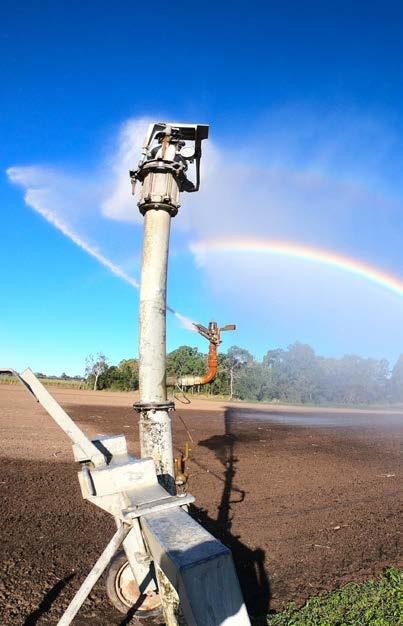
soil moisture tension - how hard it is for the plant to extract water - at one specific depth in the soil profile.
These relatively simple sensors have proven especially beneficial for the interim fallow crops. As the plant’s root system grows, the sensor, a gypsum block, can be easily relocated.
“We’ve got the gypsum block in at about 150mm, right at the root zone”, Steve explained as he demonstrated how soil moisture was being monitored in the corn crop.
“As this crop develops and the corn starts throwing secondary roots down, we’ll remove the gypsum block and take that down to probably around 300mm.
“Your gypsum block should be where the root zone and the extraction point is.”
When soil moisture is at full capacity, all of the fluorescent yellow flip dots on the sensor’s display are showing. As the crop extracts moisture and the soil dries out, the dots flip over, so fewer dots are showing.
It’s a simple system that is helping take the guess work out of timing irrigation events.
“Prior to the use of GDots and moisture probes we were sort of guessing when we were going to do our irrigation,” Steve said.
“That might have been from a drive around the farm, to ‘oh gee I think it's dry, we need to water’, otherwise it was a scheduled program making sure our nutrition and herbicides are irrigated in to stop movement.
“We probably thought we were irrigating right before, but now we know.”
In addition to the GDot sensors, the Muscats employ a more sophisticated system to monitor irrigation demands in their cane crops.
Five fixed soil moisture capacitance probes, strategically located on the farms, measure soil moisture at 10cm intervals from ground level to a depth of 80cm.
The fully encapsulated Enviropro probes are connected to data loggers that upload information via the 4G mobile network to an online interface.
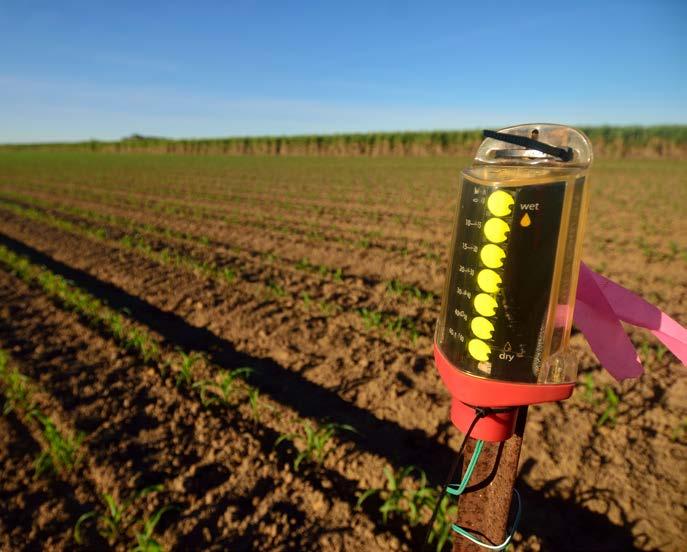
Mackay Area Productivity Services has partnered with firm Outpost Central to deliver the technology and software applications, which allow growers to monitor their crop water use in real time.
“It’s basically a website. We can access that information on our phone or our computers at home,” Steve said.
“It’s like a tradition in the morning when you’re getting up to have your cup of tea or coffee, you’re flicking through the weather and that’s just the next page I go to, what our moisture probes have done in the past 24 hours.”
Growers can also view data from neighbouring farms that are connected to the network, via the MAPS website.
The system was established with funding through the Queensland Government’s former Rural Water Use Efficiency program. Ongoing upkeep of the network is being assisted with funding provided to MAPS via CANEGROWERS, by the Queensland Government’s Farm Water Futures program.
On the ground it’s allowing extension organisations like MAPS to keep the systems up-and-running and continue to assist growers in managing irrigation.
“The equipment does get damaged and does have wear and tear on it so this funding is really important for us to keep this project going,” David said. “It’s really important for us as an extension organisation to keep working with growers on irrigation efficiency.
“To get better sugarcane you have to water it efficiently, be timely and not waste the water because power and water are really expensive.”
The next step is to get growers connected to the irrigation management tool Irrigweb, where they can enter paddock data, soil data and irrigation techniques into a software system that will assist with management of irrigation events.
It’s a work in progress in Mackay but with several growers already interested, there are hopes of delivering further efficiencies in irrigation management.
“Yield is determined from a very young age in most plants so our goal is to try to maximise our yield to maximise profitability of our business,” Steve said.
“We don’t want to be over-irrigating and wasting that commodity and we’ don’t want to be under-irrigating and reducing our yields.”
Supported by
The Queensland Government’s Farm Water Futures Program is funded under the Natural Resources Investment Program 2018-2022.
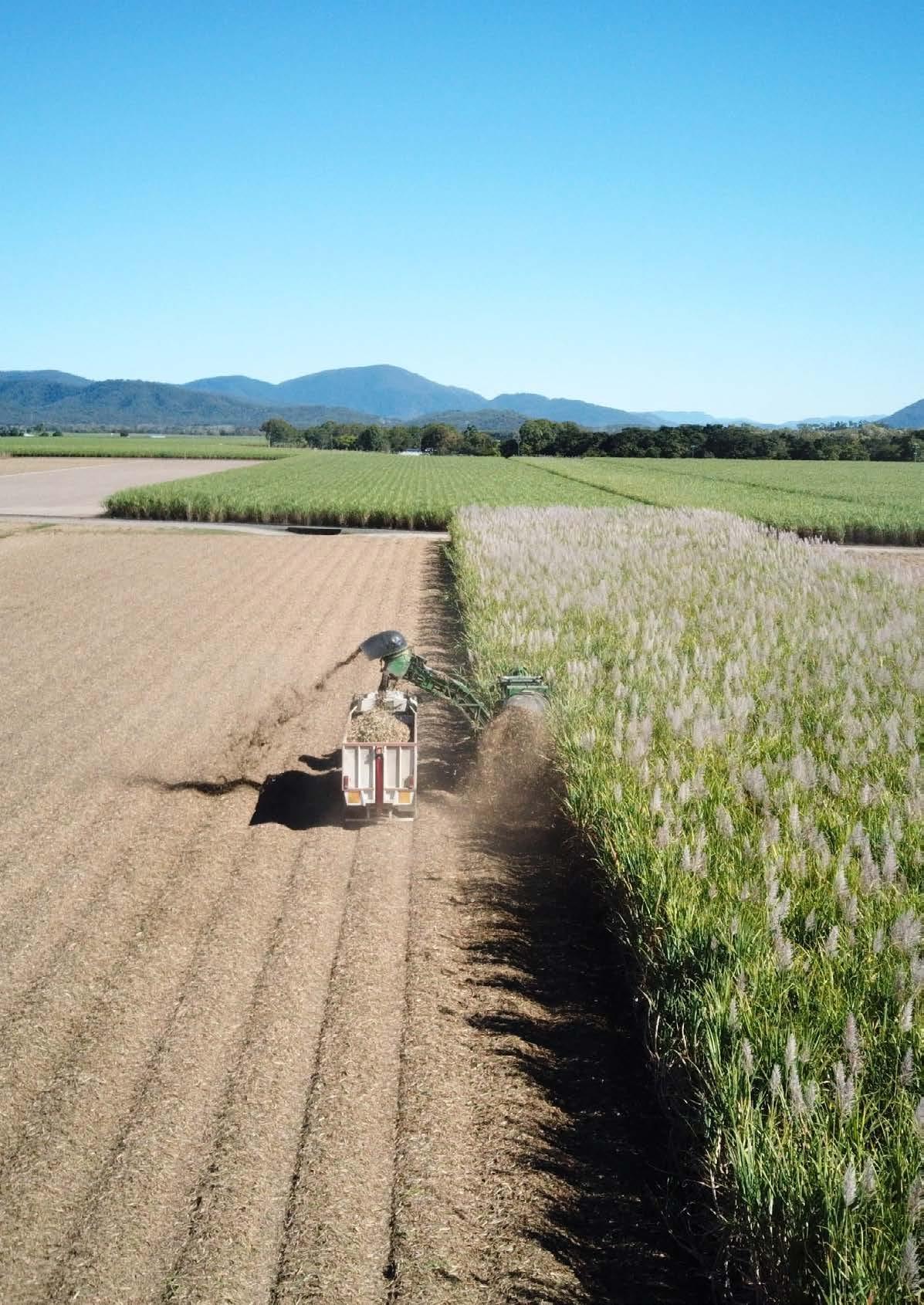
Pictured: Innisfail BMP grower Joe Zappala.

STRIVING FOR SUSTAINABILITY THROUGH SMARTCANE BMP By John Barbetti Smartcane BMP Facilitator - Tableland
Adaptability has been key to the Rankine family’s farming success. From operating the north’s largest saw mill in the heyday of timber industry to moving into cattle and mixed cropping when north Queensland's timber trade wound up in the late-80s, through to Doug Rankine’s decision to plant cane in 1995 when the Tableland sugar industry was in its infancy - the family has never shied away from new challenges.
It is this ability to adapt that has seen the family embrace practice change and new technologies in recent years in a bid to lower costs and improve production through better weed, pest and irrigation management.
A willingness to take on big challenges also contributed to the decision by Doug’s son, Benjamin, to pack in an engineering career and return to Atherton with his family to help his dad and mum, Suzanne, run the family farm.
Benjamin, who had been working in the resources sector, has been on a steep learning curve since returning in 2018, but is enjoying the challenge.
His wife Renee, and their three boys Lachlan 7, Tristan 5 and Leighton 4, are also relishing their new environment and the natural surrounds.
“It’s been a good change from the corporate world to a family business,” Benjamin said. EMBRACING TECHNOLOGY
While crop rotation and fallow management form part of a pest and disease management plan, technology, in the form of a drone, has now been incorporated into the Rankine’s management practices. Drones are used for crop inspections for pest control, growth and growth variations, vine infestations, grub damage, pivot irrigator problems and pig activity. Cockatoos are a major pest for the Rankine’s fallow crops – especially peanuts and maize. Drones are used to scare off the birds and monitor flock movements before they enter the crop.
WATER MANAGEMENT
Water security is of concern to Doug, who sees increased demand from other agricultural industries in the Mareeba Dimbulah Irrigation Area.
Managing this finite resource is critical to achieving productivity and viability across their mixed enterprises.
The Smartcane BMP irrigation and drainage management module completed by the Rankine’s as part of their accreditation ensures that the use of irrigation water is considered and meets best practice.

Accredited growers are required to calculate the soil moisture and crop water requirements before deciding on the amount of water to be applied. Run-off is managed to prevent unnecessary losses of both water and sediment.
The Rankine family uses enviroscan and irrigweb technology to monitor and record their irrigation activities. ACCREDITATION
The Rankine family achieved Smartcane BMP accreditation in April 2019. Whilst the business’ aim has always been to drive efficiencies, and by default, deliver best practice, Smartcane BMP has brought an added focus to how the farm operations interact more broadly beyond the farm gate. Benjamin sees the future of Smartcane BMP continuing to evolve; to incorporate more practices for key fallow crops, to complete the cane growing system and deliver a program that further meets the needs of dynamic growers.
Tree change: Renee and Benjamin moved back to the Rankine family farm with their boys (L-R) Leighton, Lachlan and Tristan in 2018. Before that, Benjamin's parents Suzanne and Doug (opposite) had managed the farm alone.
OAKY CREEK - THREE YEARS ON
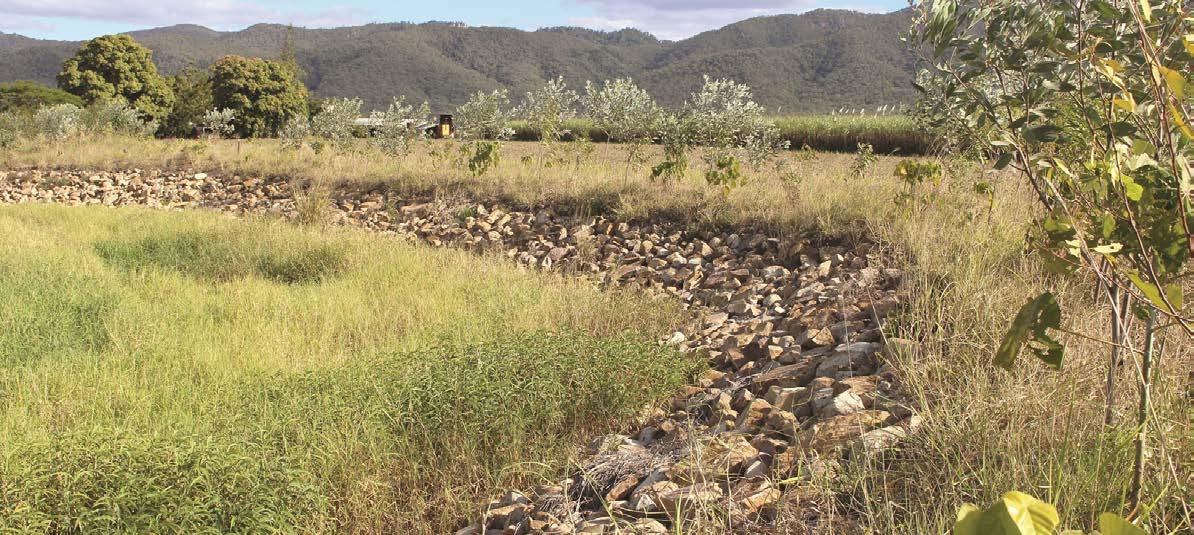
By Christine Walker, CANEGROWERS Mackay
The weather was cool and fine and Oaky Creek was dry as a bone when Australian Canegrower visited Lightning Ridge Farming recently. In fact, it was so fine that Eton Irrigation Scheme Director John Muscat had been irrigating to keep moisture up to his cane. The scene was vastly different from March 2017, when Cyclone Debbie crossed the coast bringing destructive winds and an associated wet weather system that pounded the region for three days, dumping more than 1200 mm of rain.
Oaky Creek, a tributary of Sandy Creek, 20 kilometres southwest of Mackay, was among several creeks in the region which became raging rivers in the wake of the cyclone. It overflowed into surrounding paddocks, removing top soil and dumping tonnes of rock and debris into cane fields.
The large washouts gouged gullies in productive cane land owned by growers along the creek, including Jan and John Muscat at Oakenden who supply up to 12,000 tonnes annually to Racecourse Mill.
Oaky Creek runs through their property and they lost a block of fallow when a deep new drain was gouged out through the middle of the paddock. The rocks deposited along the banks made the land unusable. Three years later, they’re still picking debris.
Another 15-20 metres of headland and cane fields were washed directly into the creek. Around 100 tonnes of production across 10 hectares were lost, while irrigation pipes in other areas were exposed. The farm was without electricity for more than a week but unlike others in the area they still had road access.
It was the biggest, most destructive flood the Muscats had seen, despite having been through several cyclones. Tens of thousands of tonnes of sediment washed out to sea.
“I’ve lived in the area for more than 50 years,” said John. “But I’ve never seen anything like this before.”
John was among the growers fortunate enough to receive a government grant to help him repair the damage to his farm, but he says he still spent thousands of dollars of his own money in filling damaged areas with 10,000 cubic metres of soil.
In the process, John created a four metre deep recycling pit to provide soil to repair damage to the paddocks.
Of course, it was beyond John and his neighbours’ capability to cover the cost of repairing the damage to the creek.
CANEGROWERS Mackay and Reef Catchments stepped in to jointly fund an assessment of the impact caused by the cyclone to Oaky Creek and other waterways, partnering with the Whitsunday Rivers Improvement Trust.
The assessment (undertaken by Alluvium Consulting) included a week of in-field surveys and site inspections.
Oaky Creek was placed at the top of the list of the most significantly affected sites and creek lines throughout the Mackay Whitsunday region.
Funding was secured under Natural Disaster Relief and Recovery Arrangements (NDRRA) Category D, jointly provided by both State and Federal governments.
The application was successful for both Stage 1 ‘urgent’ and Stage 2 activities.
Three community consultation meetings were organised for stakeholders, including landholders near the creek, CANEGROWERS Mackay, Reef Catchments, Mackay Sugar, Mackay Regional Council, Ergon, Sunwater, and the Department of Agriculture and Fisheries.
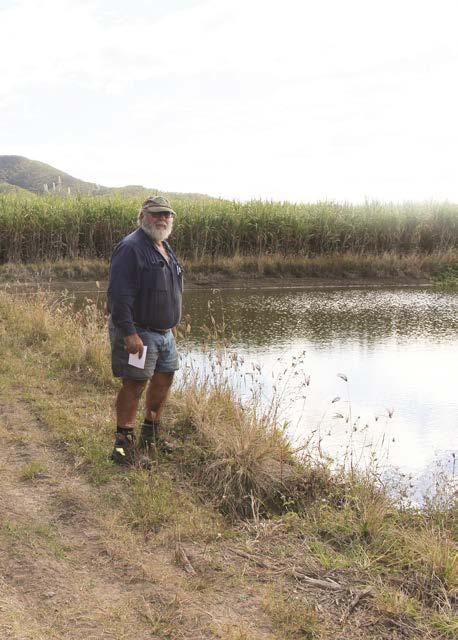

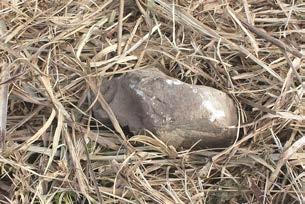
Pictured: (page 32) Oaky Creek following restoration work. (Left) John Muscat stands near the recycling pit he built to provide soil to repair damage to his paddocks; (top) Damage wrought by Oaky Creek on the Muscat farm; (left) Three years on large rocks in the paddocks are still a problem.
Stage one funding of $1.67 million was directed to eight priority sites, of which Oaky Creek was one. Initially Oaky Creek was to receive just $800,000, but Reef Catchments accessed additional funding and in all about $1.3 million was spent. Spatial analysis and hydrological modelling created a creek restoration plan that addressed community concerns whilst also stabilising the waterway using rock reinforcement and/or large woody debris. A riparian buffer zone was extensively revegetated for long-term stability. The Oaky Creek restoration was the first key project as funding became available. Further ‘shovel ready’ projects were undertaken as funding was able to be sourced.
CANEGROWERS Mackay worked to ensure growers were an integral part of the evaluation, planning and final project. While not every idea could be incorporated because of funding constraints, local knowledge influenced the design and end result. Following the completion of the project in June 2019, Reef Catchments, with funding provided by the Queensland Department of Agriculture and Fisheries under the Reef Water Quality program, continued to support landholders to maintain the revegetation. Reef Catchments had planned to hold a stakeholder event this year, including a field walk to highlight and celebrate what has been achieved since the first community consultation meeting held in March 2018 but unfortunately, COVID-19 has so far prevented this. Plans are afoot to bring it about later in the year. In the meantime, there is a PowerPoint presentation which highlights the scale of the works undertaken and what has been achieved in a relatively short amount of time with the support of the surrounding landholders. A copy can be obtained by contacting CANEGROWERS Mackay on 07 4944 2600 or Reef catchments on 07 4968 4200.








